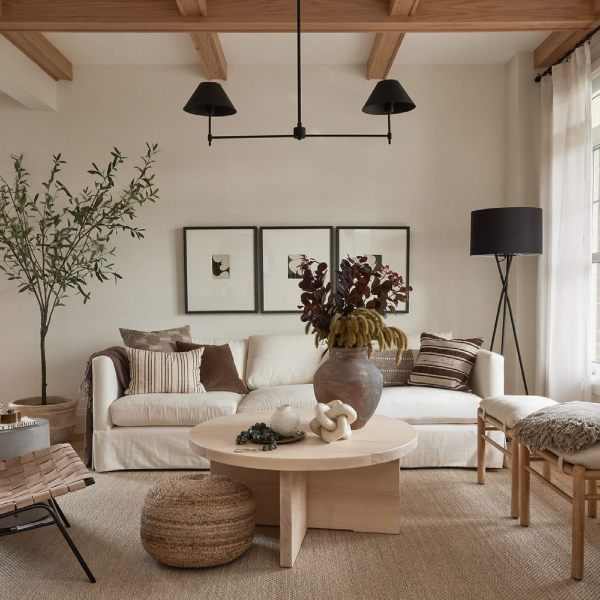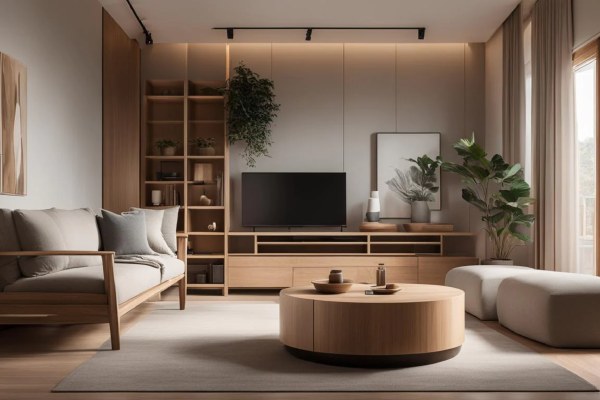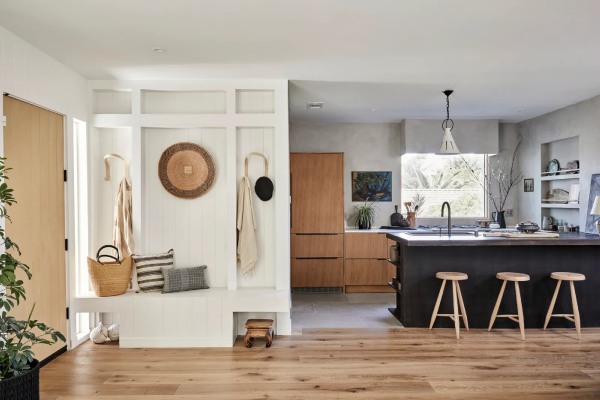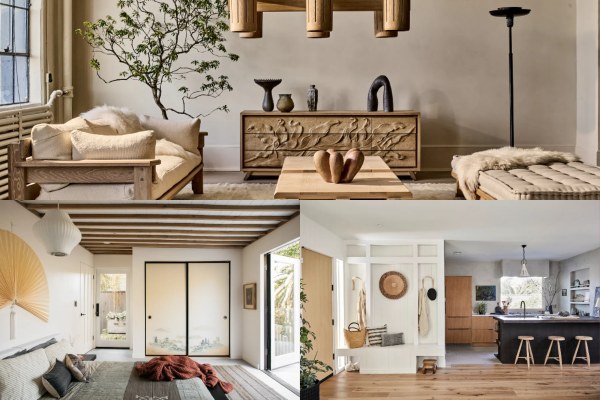Japandi interior design mixes Japanese and Scandinavian styles. It combines Scandinavian cleanliness with the tranquility characteristic of Japanese aesthetics. This style likes to keep things simple, using natural materials and making sure you feel comfy.
When you enter Japandi-style interiors, you will see light-colored wooden furniture, simple designs, and an ambiance reminiscent of Scandinavian homes. But if you look closely, you will notice elements of Japanese culture such as sliding doors and woven mats. These styles together make modern yet timeless rooms, quiet but welcoming.
That’s why lots of people enjoy Japandi design. It creates homes that are both fashionable and calming. In this article, we will check out the origins of Japandi design, how Japanese and Scandinavian styles combine, and some tips for bringing Japandi style into your home.
What is the origin of Japandi interior design?
The name “Japandi” is a mix of “Japan” and “Scandi.” The style started about 150 years ago when Danish artists visited Japan searching for new inspiration. Back then, not many people went to Japan, so when Danish artists visited they fell in love with the local artistry, skill, and the beauty of nature there.

Scandi style, coming from places like Sweden, Denmark, and Norway, is all about cozy, practical vibes to beat the cold winters. Japanese style, on the other hand, digs simplicity, elegance, and chilling in a nature-filled space. As a result, Japandi became popular among interior designers and homeowners alike for its ability to balance simplicity and functionality while promoting a clutter-free, peaceful environment.
Elements of Japanese and Scandinavian Influence
The fusion of Japanese and Scandinavian design elements creates an eye-catching interior design style that prioritizes both functionality and beauty. Japandi style focuses on natural materials like wood and stone to create a connection with nature, reflecting Japanese ideas like wabi-sabi, which finds beauty in imperfections, as well as Scandinavian appreciation for simplicity and functionality.
The color palette of Japandi interiors is muted, with a focus on earth tones that generate a sense of tranquility and closeness. Similarly, furniture is chosen for its shape and function, with clean lines and minimal decoration, reflecting the Scandinavian influence.
In terms of textiles, the Japandi aesthetic favors natural fibers such as wool, cotton, and linen, which bring warmth and texture to the area without overwhelming it. The lighting in a Japandi area is soft and indirect, providing a pleasant and inviting ambiance. The Scandinavian concept of hygge, which emphasizes comfort and coziness, complements the Japanese idea of creating settings that promote well-being and harmony.
Japandi design also prioritizes sustainability, with an emphasis on craftsmanship and durability, preferring long-lasting over disposable items. Generally, the art and decoration are simple, with an emphasis on handcrafted items that tell a story or connect to nature.
Tips for Incorporating Japandi Design at Home
The Japandi design philosophy values mindfulness and environmental sustainability, emphasizing long-lasting, high-quality elements that contribute to a tranquil and coherent living environment. The popularity of Japanese interior design can be attributed to its ability to blend aesthetic appeal with comfort.
Here are some styling ideas for your home that incorporate Japanese interior design.
Minimalism

Japandi style is all about keeping things simple and useful at home. Every item has a purpose and a spot to stay. This way of designing your home doesn’t just make it look nice, it also inspires a lifestyle that values simplicity, choosing good stuff over having lots of stuff. It helps to make your home a calm, organized, and thoughtful place to live.
Natural Materials
In Japandi-style homes, using natural materials is super important to create a peaceful vibe. You can use things like wood, bamboo, stone, and rattan. Wood is great for furniture and floors because it feels warm and adds texture. Bamboo is cool because it’s eco-friendly and can be used in lots of ways. Stone makes things feel strong and stable, like on countertops or walls. Rattan is nice for adding a bit of natural beauty, often seen in chairs or lamps.
Clean Lines
Clean lines in Japanese design indicate that furniture and decor furniture and decor have simple and straight shapes, without any fancy or complicated designs. This makes the space feel tidy and organized, without any clutter. Furniture with clean lines features straight edges, smooth surfaces, and simple designs, making it simple to use. This style makes the room feel calm and balanced, letting the natural materials and textures stand out.
Natural Color Palette
Stik to colors that are usually soft and gentle, like muted whites, warm browns, and light grays. These colors make the space feel calm and balanced, like being in nature. They match well with the natural materials used, such as wood and stone, making the whole place feel unified and peaceful.
Embrace Wabi-Sabi
Embracing wabi-sabi while incorporating Japandi design at home adds depth and warmth to your living space. It brings a sense of authenticity and appreciation for the beauty of imperfection and impermanence. By including elements that reflect wabi-sabi principles, such as using weathered materials or handmade items, you create a space that feels lived-in and welcoming.
Bring in Nature
Adding elements from nature to your home makes it feel calm and peaceful. Things like plants, sunlight, and natural materials help you feel connected to the outdoors, which can help you relax and feel better. Having these things in your home not only makes it look nicer but also helps keep the air cleaner and healthier. By bringing nature into your home, you can make it feel cozy and welcoming.
Benefits of Japandi Interior Design
Japandi interior design offers numerous benefits that contribute to creating a harmonious and inviting living environment such as:
- Japandi interior design combines the best elements of Japanese minimalism and Scandinavian functionality, making a space that is both aesthetically pleasing and practical.
- The primary advantage of Japandi interior design is its capacity to produce a sense of tranquillity and relaxation through its minimalist aesthetic and focus on clean lines.
- This focus on functionality promotes efficiency and organization in the home, making it easier to maintain a tidy and clutter-free environment.

- Another good thing about Japandi interior design is that it uses natural materials and textures.
- Exposure to natural elements can improve mood and overall well-being, therefore Japandi design is a popular choice for creating healthy and caring living environments.
- Japandi design embraces the concept of wabi-sabi, celebrating the beauty of imperfection and impermanence.
- Further, it offers versatility and adaptability, making it suitable for a wide range of architectural styles and personal tastes.
Frequently Asked Questions
1. What is Japandi Interior Design?
Japandi interior design mixes Japanese and Scandinavian styles. It combines Scandinavian cleanliness with the tranquility characteristic of Japanese aesthetics.
2. What are the key features of Japandi Interior Design?
Japandi style focuses on natural materials like wood and stone to create a connection with nature, reflecting Japanese ideas like wabi-sabi, which finds beauty in imperfections, as well as Scandinavian appreciation for simplicity and functionality.
3. What is the philosophy behind Japandi Interior Design?
The Japandi design philosophy values mindfulness and environmental sustainability, emphasizing long-lasting, high-quality elements that contribute to a tranquil and coherent living environment.
Also read, Lanai Decor: Furnishing and Decorating Tips – Pros, Cons, Differences, And More
